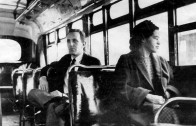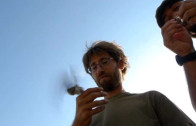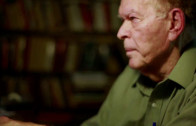Eyes on the Prize
Eyes on the Prize tells the story of the civil rights era from the point of view of the women and men whose extraordinary actions launched a movement that changed the fabric of American society, and embodied a struggle whose reverberations continue to be felt today. It is the story of the people–young and old, male and female, northern and southern–who, compelled by a meeting of conscience and circumstance, worked hard to eradicate a world where whites and blacks could not go to the same school, ride the same bus, vote in the same election, or participate equally in society. It was a world in which peaceful demonstrators were met with resistance and brutality–a reality that is now nearly incomprehensible to many young Americans. Through contemporary interviews and historical footage, Eyes on the Prize traces the civil rights movement from the Montgomery bus boycott to the Voting Rights Act; from early acts of individual courage through the flowering of a mass movement and its eventual split into factions.
Series
Individual acts of courage inspire whole communities of black people to fight for their rights: Mose Wright testifies against the white men who murdered young Emmett Till, and Rosa Parks refuses to give up her bus seat to a white man in Montgomery, Alabama.
States’ rights loyalists and federal authorities collide in the 1957 battle to integrate Little Rock’s Central High School, and again in James Meredith’s 1962 challenge to segregation at the University of Mississippi. Both times, a Southern governor squares off with a US president, violence erupts, and integration is carried out.
Black college students take a leadership role in the civil rights movement as lunch counter sit-ins spread across the South. Freedom Riders also try to desegregate interstate buses, but they are brutally attacked as they travel.
Examines the failed attempt by the Southern Christian Leadership Conference (SCLC) in Albany, Georgia to end racial segregation and the subsequent lessons learned to win a major victory in Birmingham, Alabama during the Birmingham campaign. The film also covers the March on Washington, one of the largest political rallies for civil rights in the history of the United States. The Civil Rights Act is proposed.
Chronicles the murder of Medgar Evers in 1963 and the murders of Chaney, Goodman, and Schwerner in 1964 in Mississippi. The film also covers the Mississippi Freedom Democratic Party (MFDP) attendance at the Democratic National Convention in Atlantic City during the United States presidential election of 1964.
A decade of lessons is applied in the climactic and bloody march from Selma to Montgomery, Alabama. A major victory is won when the federal Voting Rights Bill passes, but civil rights leaders know they have new challenges ahead.
After a decade-long cry for justice, a new sound is heard in the civil rights movement: the insistent call for power. Malcolm X takes an eloquent nationalism to urban streets as a younger generation of black leaders listens. In the South, Stokely Carmichael and the Student Nonviolent Coordinating Committee (SNCC) move from “Freedom Now!” to “Black Power!” as the fabric of the movement changes. The episode also chronicles the political organising work of the Lowndes County Freedom Organization (LCFO) in Alabama and the shooting of James Meredith during the March Against Fear.
Martin Luther King, Jr. and the Southern Christian Leadership Conference (SCLC) come north to help Chicago’s civil rights leaders in their non-violent struggle against segregated housing. Their efforts pit them against Chicago’s powerful mayor, Richard Daley. When a series of marches through all-white neighbourhoods draws violence, King and Daley negotiate with mixed results. In Detroit, a police raid in a black neighbourhood sparks an urban uprising that lasts five days, leaving 43 people dead. The Kerner Commission finds that America is becoming “two societies, one black, one white, separate and unequal.” President Lyndon Johnson, who appointed the commission, ignores the report.
The call for Black Power takes various forms across communities in black America. In Cleveland, Carl Stokes wins election as the first black mayor of a major American city. The Black Panther Party, armed with law books, breakfast programs, and guns, is born in Oakland. Substandard teaching practices prompt parents to gain educational control of a Brooklyn school district but then lead them to a showdown with New York City’s teachers’ union.
Martin Luther King stakes out new ground for himself and the rapidly fragmenting civil rights movement. One year before his death, he publicly opposes the war in Vietnam. His Southern Christian Leadership Conference (SCLC) embarks on an ambitious Poor People’s Campaign. In the midst of political organising, King detours to support striking sanitation workers in Memphis, where he is assassinated. King’s death and the failure of his final campaign mark the end of a major stream of the movement.
A call to pride and a renewed push for unity galvanise black America. World heavyweight champion Cassius Clay challenges America to accept him as Muhammad Ali, a minister of Islam who refuses to fight in Vietnam. Students at Howard University in Washington, D.C., fight to bring the growing black consciousness movement and their African heritage inside the walls of this prominent black institution. Black elected officials and community activists organise the National Black Political Convention in Gary, Indiana, in an attempt to create a unified black response to growing repression against the movement.
Black activism is increasingly met with a sometimes violent and unethical response from local and federal law enforcement agencies. In Chicago, two Black Panther Party leaders are killed in a pre-dawn raid by police acting on information supplied by an FBI informant. In the wake of President Nixon’s call to “law and order,” stepped-up arrests push the already poor conditions at New York’s Attica State Prison to the limit. A five-day inmate takeover calling the public’s attention to the conditions leaves 43 men dead: four killed by inmates, 39 by police.
The documentary examines the Boston school desegregation crisis involving busing in Massachusetts. The second part of the film chronicles the election of Maynard Jackson as mayor of Atlanta and the first African American to become mayor of a major U.S. city in the southern United States. The last part of the film examines affirmative action and the landmark United States Supreme Court ruling Regents of the University of California v. Bakke (1978).
Covers the Miami riot of 1980 and the election of Harold Washington as the first African-American mayor of Chicago. The film finishes with an overview of the Civil Rights Movement and its effect upon the United States and the world.




